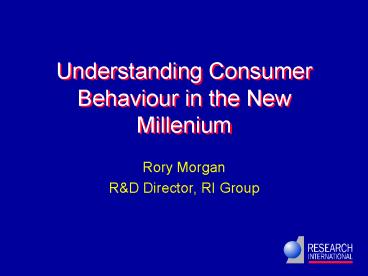Understanding Consumer Behaviour in the New Millenium - PowerPoint PPT Presentation
1 / 33
Title:
Understanding Consumer Behaviour in the New Millenium
Description:
Which definition is best? Emotional loyalty. Measured by affect', e.g. attitudes. brand beliefs ... Holidays. Implications for the future ... – PowerPoint PPT presentation
Number of Views:131
Avg rating:3.0/5.0
Title: Understanding Consumer Behaviour in the New Millenium
1
Understanding Consumer Behaviour in the New
Millenium
- Rory Morgan
- RD Director, RI Group
2
Defining our terms
- Loyalty (to brands, services etc.) has become
they most significant aspect of behaviour
requiring understanding - But what do we mean by loyalty?
3
Which definition is best?
Emotional loyalty
Behavioural loyalty
- Measured by affect, e.g.
- attitudes
- brand beliefs
- liking, preference
- behavioural intention
- BUT
- There are other measures
- Potentially redundant
Measured by observation Of ultimate
interest BUT Difficult to incorporate into
ad-hoc methods
4
In an ideal world ...
- we would want the best of both!
- I.e. using questionnaire based methods measuring
affective topics, but able to make an accurate
prediction of consumer choice behaviour - The Holy Grail of researchers for many years.
Modeling actual behaviour
5
Why bother?
- If we can model behaviour, then we can predict it
- Examine strengths and weaknesses of brand
positions - Develop marketing strategies designed to maximise
attraction/minimise defection - Identify individuals of opportunity and risk
6
Two approaches to survey analysis
Question by question
Across questions
7
A simple decision model
Behaviour
8
AFFINITY Emotional
BRAND EQUITY
BRAND VALUE
PERFORMANCE Functional
PRICE
RI Equity Enginesm
9
Affinity
- The closeness of a brand to a person, together
with its authority and potential for the
individual
Measured by conventional brand image uni-polar
ratings
10
Affinity Authority
11
Affinity Identification
12
Affinity Approval
13
Performance
- Category specific issues
- Product features/configuration
- Functional benefits
- Customer service topics
14
Developing the model
- Essentially a hierarchical model, incorporating
standard elements of a survey questionnaire - Weights estimated using a Genetic Algorithm
15
A Typical Model
Heritage 43
Authority
EQUITY
Trust 15
Affinity
Innovative 42
Bonding 34
Identification
Performance
Caring 33
Approval
Nostalgia 33
Endorsement 17
Prestigious 18
Acceptability 65
Source Credit Cards Market
16
including performance issues
EQUITY
Affinity
Performance
Benefits 10
Direct 32
Customer Service 11
Accepted Everywhere 37
Competitive Charges 10
Source Credit Cards Market
17
Genetic algorithms
- General purpose optimisation tool
- Based on principles of evolutionary theory
- Finds best fitting parameters within a given set
of constraints - Constraints are very useful
- Iterative - so computer intensive
18
A simple (!) problem
- A travelling salesman has to visit 25 locations
in turn (A,B,C,D etc.) - The exact positions of each location is known.
- What is the single sequence of visits that
results in the shortest travelling time?
19
A Genetic Algorithm solution
- Generate a large number of possible routes
- ACUSDIXOS..
- JITPBEXZAI
- HUWVDIEQB.. Etc. (Maybe 100 or so.)
- Work out how good each route is.
- Take the best ten, and discard the others.
- Make up the full number of routes by mutating
the top ten. - Repeat the process until the best answer is
good enough.
20
The way it works
Take the best cases and generate a new set from
them
Eventually some extremely good solutions are
uncovered
Take the best cases and generate a new set from
them
Good
Bad
21
All things are relative ...
Affinity
Equity
Value of CURRENT brand
Performance
Price
Affinity
Equity
Value of ALTERNATIVE brand
Performance
Price
22
Relationship to behaviour is not linear ...
Probability of switching
100
75
50
25
0
Utility difference between CURRENT and NEW
Source RI Conjoint studies
23
Category Differences
Local telephone
airlines
Loyalty
hospitals
automobiles
Relative brand value
Source Jones and Sasser
24
Our ultimate objectives
- To answer the following client questions
- How loyal are my existing customers?
- What are the key factors in creating and
weakening loyalty? - What additional customers may be available to me,
and how do I get them? - What is the impact on customer loyalty of my
strategies?
25
Why do people behave differently?
Overall inclination/ preference
Intervening variables
Actual behaviour
Inertia Circumstance Barriers to switching
26
The concept of inertia
- There are factors which act to inhibit (but
possibly promote) the likelihood that an
individual will act on their evaluation of
product alternatives - These factors operate at the individual consumer
level - Therefore, each individual interprets relative
brand values in the light of their own constraints
27
Inertia
Unhappy prisoners
Secure brand fans
MEDIUM switching
LOW switching
Relative current brand value
Committed volunteers
Early leavers
HIGH switching
MEDIUM switching
28
An extended model
Brand equity
Brand attractiveness
Price
LOYALTY
Experimentalism
Inertia
Confidence
Barriers
RI Loyalty Driversm
29
Experimentalism
- INDIVIDUAL oriented
- Brand differentiation
- Habit
- Variety seeking
- Shopping around
- Susceptibility to new offers
- Importance of right choice
30
Confidence
- CATEGORY oriented
- Knowledge of the category, issues, etc.
- Understanding of the products
- Predictability/transparency of products
31
Barriers to choice
- CATEGORY specific - both physical and
psychological - Effort required to switch
- Availability/difficulty in acquisition
- Financial implication
- Compatibility with prior choices
- Ancillary benefits
- etc.
32
Market Models
Continuous contract Opt-out
defecting Banks Utilities
Regular purchasing Probabilistic Market
share/ volume Airlines Hotels FMCGs
Infrequent purchasing Buy/not buy
purchasing Durables Holidays
33
Implications for the future
- Survey research is increasingly linked to causal
models that are constructed for specific purposes - Questionnaire content is increasingly driven by a
priori hypotheses - Analysis will include an increasing amount of
vertical modelling
34
(No Transcript)































